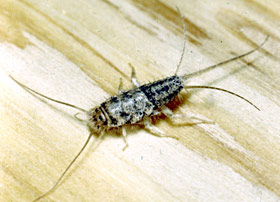Silverfish, Lepisma saccharina; Firebrats, Ctenolepisma spp. and Thermobia spp.

Clemson University - USDA Cooperative Extension Slide Series, Bugwood.org.
IPM Steps to Reduce Silverfish and Firebrats
1. Sample for Pest
Confirm the presence of these pests.
Where to find it while inspecting: These insects need moisture in their environment and will rarely be found in dry areas of buildings. Because their food preferences are so wide they can be found in many areas: traditional food service areas as well as where the only food source is paper products. Look for them on damp boxes, fabric, and in containers where they’ve found moisture. Look in warm, high humidity areas, including kitchen equipment such as coffee makers. Consider them a pest of paper as well as stored food. Watch for them to “run fast” when threatened; they also jump sideways. Firebrats prefer a drier habitat than silverfish.
Before you act, determine what is crawling around on your floor.
Size and Particulars: Silverfish and firebrats are very similar—silver to gray in color 1/2"–3/4" in length not including “tails”. Scaled, wingless, flat. They have three bristle-like “tails” and two long antennae.
3. Learn the Pest Biology

Clemson University - USDA Cooperative Extension Slide Series, Bugwood.org.
Knowing the life cycle and habitat needs helps you fight these pests.
Life Cycle: Egg, nymph (immature versions of adult, without “scales”) and adult. Eggs are laid in protected areas.
Preferred Food Sources: Paper, cotton, proteins, glue, paste, dried meats, oats, flour. They are known to damage books and documents.
Preferred Habitat: Warm, moist areas for silverfish, warm, drier areas for firebrats.
4. Determine Threshold
Silverfish and firebrats are unpopular guests, but what is your threshold for infestation? When should you act?
Threshold: Sightings should prompt an inspection for areas that accommodate infestation.
5. Choose Tactics
IPM for indoor pests is always a combination of exclusion and sanitation: Try to keep them out. Don’t provide water, food and shelter if they enter your building.
Best Management Practices: Sanitation and reducing moisture. Remove clutter and increase ventilation. Protect food, paper, books by storing in pest-proof containers if you can’t regulate humidity and temperature.
Treatment Methods: Drying out a location and removing food sources will reduce populations. Monitor for activity. If you are unable to reduce humidity, you may have to opt for pesticide treatment if damage is occurring.
6. Evaluate
Was the tactic successful? Record the date pests were first noted, and the tactic you used, and its success. Use one of our RECORD KEEPING tools.
For More Information:
Penn State Extension: Bristletails (Silverfish and Firebrats)
Remember:
When a pesticide application is necessary, all necessary and required precautions are taken to minimize risk to people and the environment and to minimize risk of pesticide resistance or pest resurgence. Pesticide use in your school may be prohibited or regulated by local policies or state and federal regulations. Risk reduction methods can include, but are not limited to, spot-treatment, the use of gel or paste bait formulations placed in inaccessible locations, injection into a crack or crevice, and other methods that reduce potential exposure.